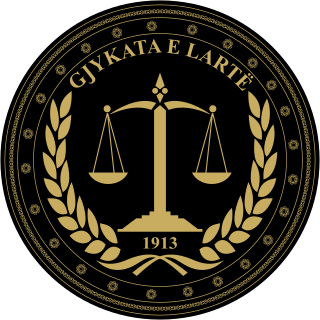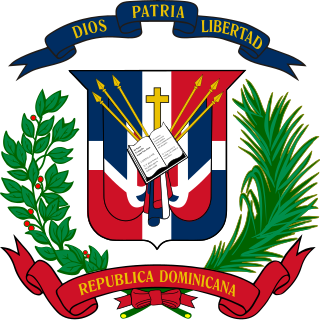This page is based on this
Wikipedia article Text is available under the
CC BY-SA 4.0 license; additional terms may apply.
Images, videos and audio are available under their respective licenses.

District courts are a category of courts which exists in several nations. These include:
In France, career judges are considered civil servants exercising one of the sovereign powers of the state, so French citizens are eligible for judgeship, but so are all citizens of the EU countries. France's independent court system enjoys special statutory protection from the executive branch. Procedures for the appointment, promotion, and removal of judges vary depending on whether it is for the ordinary or administrative stream. Judicial appointments in the judicial stream must be approved by a special panel, the High Council of the Judiciary. Once appointed, career judges serve for life and cannot be removed without specific disciplinary proceedings conducted before the Council with due process.
The Alaska Court of Appeals is an intermediate court of appeals in the State of Alaska's judicial department, created in 1980 by the Alaska Legislature as an additional appellate court to lessen the burden on the Alaska Supreme Court. The court of appeals consists of a chief judge and two associate judges, who are all appointed by the governor of Alaska and face judicial retention elections every eight years; the chief judge of the court of appeals is selected from among the three by the chief justice of the supreme court to serve a two-year term.

The judicial system of Turkey is defined by Articles 138 to 160 of the 1982 Constitution. Civilian and military jurisdiction are separated. While military courts usually only try military personnel, they can also try civilians in times of martial law and in matters concerning military service.

The law of Brazil is based on statutes and, partly and more recently, a mechanism called súmulas vinculantes. It derives mainly from the civil law systems of European countries, particularly Portugal, the Napoleonic Code and the Germanic law.

The Judiciary of Portugal is a system of courts that together constitute one of the four organs of Sovereignty as defined by the Portuguese Constitution. The courts are independent from the other three Portuguese organs of Sovereignty.

The Superior Courts of Justice or Superior Sectors of Peru are the second highest courts of the Judicial System of Peru. It is only second to the Supreme Court. There is one court for each Judicial District which more or less correspond with each of the 25 Regions of Peru. A Superior Court is subdivided into smaller courts according to its speciality:

The Judiciary of Spain consists of Courts and Tribunals, composed of judges and magistrates (Justices), who have the power to administer justice in the name of the King of Spain.

The judicial system of Sweden consists of the law of Sweden and a number of government agencies tasked with upholding security and rule of law within the country. The activities of these agencies include police and law enforcement, prosecution, courts, and prisons and other correctional services.

The Judiciary of Brazil is the Judiciary branch of the Brazilian government. The structure and the division of jurisdiction of the ramifications of the Brazilian Judiciary is defined in the Brazilian Constitution.

In Italy, judges are public officials and, since they exercise one of the sovereign powers of the State, only Italian citizens are eligible for judgeship. In order to become a judge, applicants must obtain a degree of higher education as well as pass written and oral examinations. However, most training and experience is gained through the judicial organization itself. The potential candidates then work their way up from the bottom through promotions.
Italy's independent judiciary enjoys special constitutional protection from the executive branch.
Once appointed, judges serve for life and cannot be removed without specific disciplinary proceedings conducted in due process before the Consiglio Superiore della Magistratura.
The Ministry of Justice handles the administration of courts and judiciary, including paying salaries and constructing new courthouses. The Ministry of Justice and that of the Infrastructures fund and the Ministry of Justice and that of the Interiors administer the prison system. Lastly, the Ministry of Justice receives and processes applications for presidential pardons and proposes legislation dealing with matters of civil or criminal justice.

The Supreme Court of the Republic of Albania is the highest court of Albania and is the final court of appeal in the judicial system of Albania. It is composed of seventeen judges, the Chief Justice and sixteen Members.

The Federal Government of Brazil is the national government of the Federative Republic of Brazil, a republic in South America divided in 26 states and a federal district. The Brazilian federal government is divided in three branches: the executive, which is headed by the President and the cabinet; the legislative, whose powers are vested by the Constitution in the National Congress; and the judiciary, whose powers are vested in the Supreme Federal Court and lower federal courts. The seat of the federal government is located in Brasília. This has led to "Brasília" commonly being used as a metonym for the federal government of Brazil.
The Judiciary of Puerto Rico is defined under the Constitution of Puerto Rico and consists of the Supreme Court of Puerto Rico, Court of Appeals, and the Court of First Instance consisting of the Superior Courts and the Municipal Courts.
The judiciary of Luxembourg comprises a number of courts.

The district courts of Sweden are the court of first instance for the general courts in Sweden. The next instance are the courts of appeal. The district court handle criminal cases, some civil law disputes and a number of non-contentious matters. There are 48 district courts across Sweden, and the catchment area is based on the geographic boundaries of several municipalities. The number of employees vary, from ten to several hundreds.

The judiciary is one of the three branches of state that make up the government of the Dominican Republic. Its function is to administer justice, for free, to decide on disputes between individuals or corporations, private or public, in all kinds of processes, judgment and execution of judgments. They exercise for the courts and tribunals established by the Constitution and the law

The High Courts are the intermediate appellate courts under the law of Taiwan. The modern court system of Taiwan was founded in 1896, under the Japanese era. Currently there are six high courts and branches in Taiwan.
















